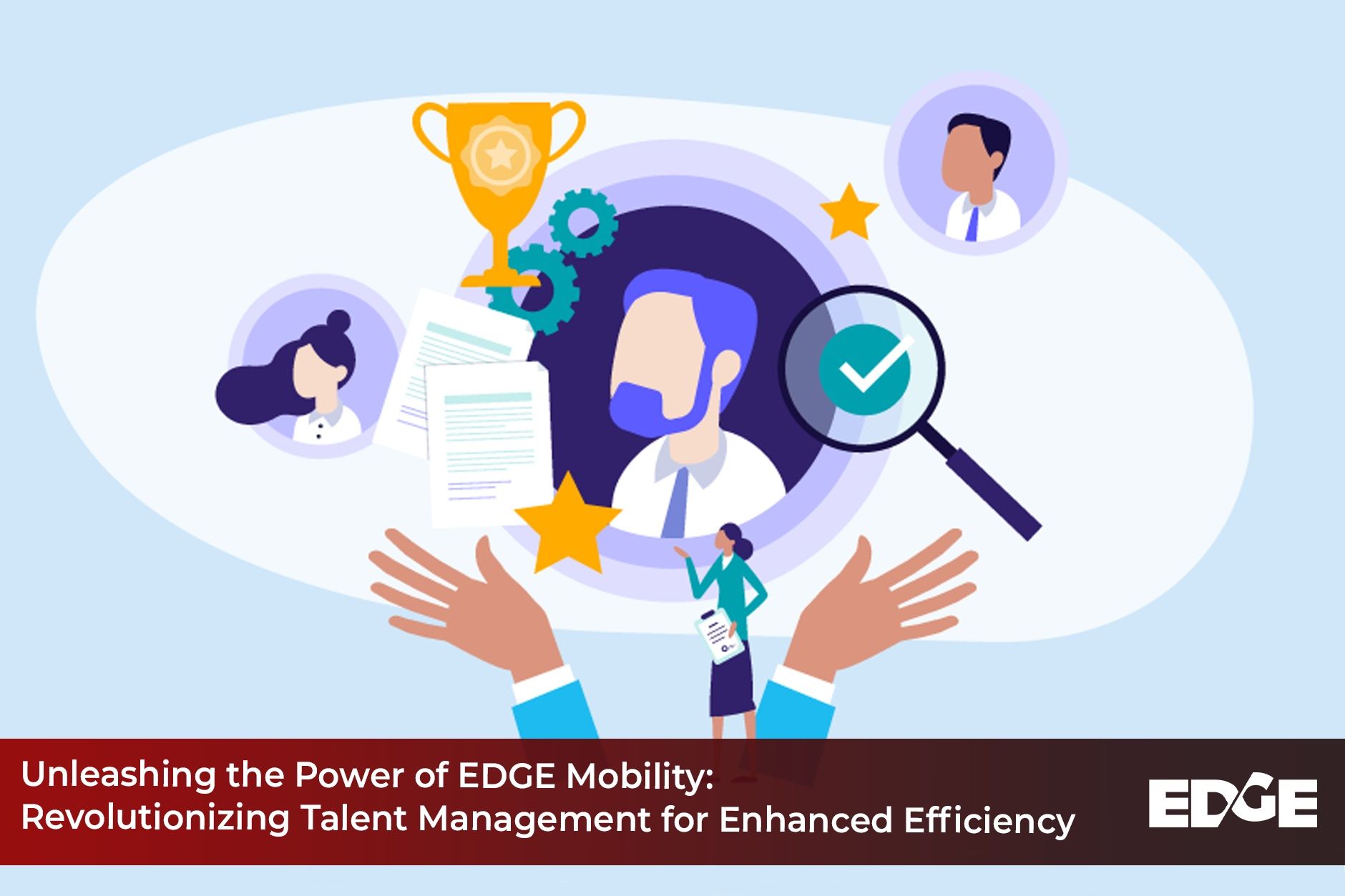
The IT industry faces numerous formidable challenges that have a significant impact on its performance. These challenges include issues with resource and skill visibility, inflated bench sizes, high external hiring costs, revenue loss due to delayed hiring, and the need to pay a premium for contingent labour.
These challenges come with substantial financial implications. On average, external hiring costs amount to approximately $20,000 per candidate, and even a minor 1% reduction in employee utilization can result in a significant revenue loss of up to 0.9%.
Extensive research has consistently shown that new hires take approximately two years to reach the same performance level as internal hires. Additionally, a comprehensive study involving over 11,000 internal hires has revealed that employees referred through informal channels consistently underperformed compared to those hired through more structured recruitment processes. This underscores the importance of employing structured approaches to recruitment.
Companies also grapple with the challenge of paying a premium for contingent labour, which can be exorbitant. This challenge is further exacerbated by the difficulty of identifying the right candidates for the job, leading to inflated bench sizes. Prominent IT firms often have around 7-8% of their resources on the bench, and optimizing this aspect has the potential to generate significant revenue.
The article explores these challenges and highlights the advantages of internal mobility for resource managers and organizations. Additionally, we introduce EDGE Mobility as an innovative solution that facilitates streamlined talent management for optimal performance and efficiency.
Exploring Different Types of Internal Mobility:
To unlock agility within organizations, resource managers can leverage various forms of internal mobility, including:
Role-to-role mobility: Also known as lateral mobility, this involves employees transitioning from one position to another within the organization, with minimal change in salary or level. Although not a vertical career move, it fosters cross-functional collaboration and knowledge-sharing.

Upward mobility: This refers to promotions where employees advance to higher job positions or functions within the same department, recognizing their exceptional performance. It boosts morale, productivity, and employee satisfaction while signalling the organization's commitment to internal growth.

Project-based mobility: Employees collaborate with colleagues from different departments on specific projects, leveraging diverse expertise. This form of mobility allows employees to contribute beyond their usual workflow and department, enhancing their skill set and fostering teamwork.

Transfers: Transfers occur when employees change their physical location while retaining the same responsibilities and compensation. They can be permanent, temporary, or ad-hoc, catering to business priorities or employee preferences.

Internal mobility platforms: Workforce agility platforms facilitate all aspects of career movement and project-based work. These platforms combine a talent marketplace, connecting employees with relevant opportunities and workforce intelligence, providing insights into skills and knowledge gaps.

Rapid technological advancements necessitate continuous learning and upskilling. Internal mobility enables organizations to address skill gaps within their workforce. Studies show that 80% of workers worldwide believe they would be more productive if given the opportunity to acquire new skills. By providing upskilling and reskilling opportunities, organizations not only enhance business outputs but also experience higher employee retention rates. Remarkably, 88% of workers express a greater willingness to remain with a company that invests in their professional development. Around 41% of employees consider career advancement opportunities as vital.
To meet these expectations, organizations must enable employees to progress within their careers without leaving the company. However, one of the biggest challenges faced by employers is the lack of visibility into their employee's skills and preferable career paths. Often, the information about an employee's skills is not easily accessible, making it difficult for organizations to match the right candidates to the right job opportunities.
This aspect is particularly significant for younger generations, with up to 87% of millennials valuing career development. Acquiring new skills and growing within their roles are key factors that employees highly appreciate.
This is exactly where internal mobility takes centre stage. It gives employers the visibility they are looking for.
The Transformative Power of Internal Mobility
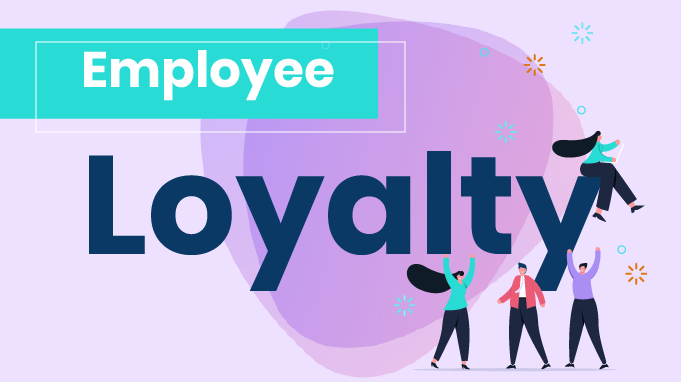
- Internal mobility cultivates loyalty and commitment among employees by providing opportunities for career growth. LinkedIn data reveals that promoting employees after three years increases the likelihood of their retention by 70%, while lateral moves result in a 62% retention chance. These statistics underscore the importance of internal mobility in talent retention.
- Internal mobility enables organizations to adopt a competency-based approach to talent management. By evaluating the specific competencies required for each role, organizations can identify the necessary skills development for employees transitioning into new positions. Research by Deloitte indicates that organizations focusing on a skill-based approach are 63% more likely to achieve successful outcomes.
The fact is global talent acquisition poses significant difficulties, with 46% of HR managers struggling to find suitable candidates globally. Optimizing internal mobility processes allows companies to effectively tap into their existing talent pool, thereby alleviating these challenges.
Internal mobility is a win-win situation, benefiting both employees and organizations. It allows employees to learn new skills and pursue roles they are passionate about, positively impacting business performance. Furthermore, investing in employee growth helps attract and retain top talent, as 94% of workers express a willingness to stay longer at companies that invest in their careers. Internal mobility also saves time and money by leveraging existing employee knowledge and reducing the costs associated with external recruitment. It improves engagement, morale, and overall employee performance.
Benefits Galore

Internal mobility offers several key benefits, including:
- Attracting and retaining top talent: Employees value growth and new challenges in their careers. A recent report from LinkedIn showed that 94% of workers would stay longer at a company if it invested in their professional development. Having an internal mobility strategy demonstrates a commitment to employee growth and provides the necessary support systems to help them achieve their career goals. Considering the high costs of talent acquisition, prioritizing talent retention is crucial for organizations concerned about their financial bottom line.
- Saving time and money: Hiring new employees, even highly skilled ones, is an expensive and time-consuming process. Research suggests that large enterprises lose over $400,000 per year due to recruitment and training costs for new hires. By promoting internal mobility, organizations can minimize the need for extensive onboarding by utilizing employees who are already familiar with the company's operations. This approach allows for a smoother transition and reduces costs associated with external hiring.
- Boosting engagement and morale: Internal mobility has a positive impact on employee engagement. When employees have opportunities to enhance their skills and broaden their experiences within the organization, they are motivated to reach their full potential. A study found that more than 63% of employees express interest in exploring new career opportunities within their company, underscoring the widespread desire for internal mobility.
Leveraging internal resources minimizes onboarding costs and allows for a smoother transition. Internal mobility drives employee engagement and performance, leading to overall business success.
Successful Internal Hiring: Clear Guidelines, Sophisticated Technology, and Candidate Experience

Thus, to ensure successful internal hiring, organizations need clear and consistent guidelines for employee movement across full-time roles, short-term rotations, or stretch assignments. Implementing a technology platform that serves as an internal job board, tracks and assesses employee skills, and offers mentoring, training and project opportunities is crucial. This platform should function as an "internal LinkedIn" within the company, integrating recruitment and learning and development efforts seamlessly.
Enter EDGE Mobility, an innovative internal talent management suite, that offers a comprehensive solution. It enables companies to internally allocate resources based on demand, evaluate competencies and skills, integrate with third-party systems, and implement configurable policies. With real-time data provided by its actionable dashboard powered by EDGE Insights, companies can make informed decisions and unlock their workforce's full potential.
EDGE Mobility is a truly integrated talent management suite that comes with standard connectors to popular systems like HCM, HRIS, ATS, LXP/LMS, and Assessment engines. With heuristics from over 1 million IT professionals across major companies in India, it empowers Resource Managers, Hiring Managers, and Account Managers to streamline their talent management processes. ….
With EDGE Mobility, organizations can expect up to 10% increase in revenue per employee with every 1% reduction in bench (or increase in net utilization).
Features aplenty
- AI-Powered Demand and Profile Analysis with ingenious Resume Parser technology conducts a comprehensive analysis of candidate resumes, considering their complete profile, allocation history & skill competencies.
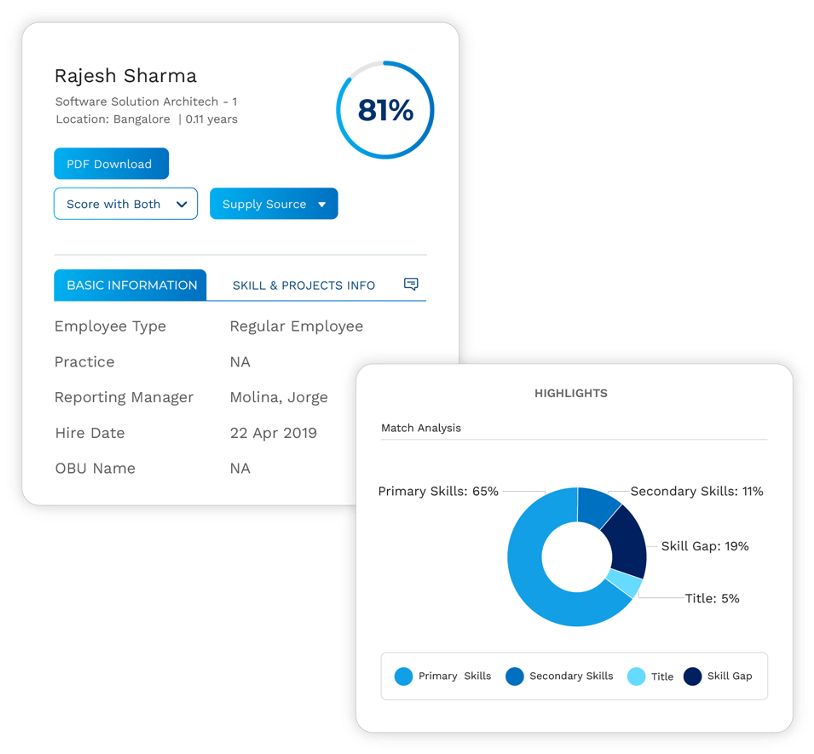
- ‘Configurable Policy Engine’ helps manage multiple business rules in a configurable format seamlessly. Set policies to establish default matches for various conditions such as bench, virtual, rotation, visa, leave, and more.
- Mark unfulfilled positions to external to flag a demand for external hiring after exploring the internal talent pool.
- Leverage powerful NLP algorithms and proprietary neural network - EDGE Graph, for seamless Search and Match capabilities. Access a stack of matching supplies, ranked according to job fitment, RSL (role, skill, location), Profitability Index%, and more with AI-enabled job-candidate scoring system.
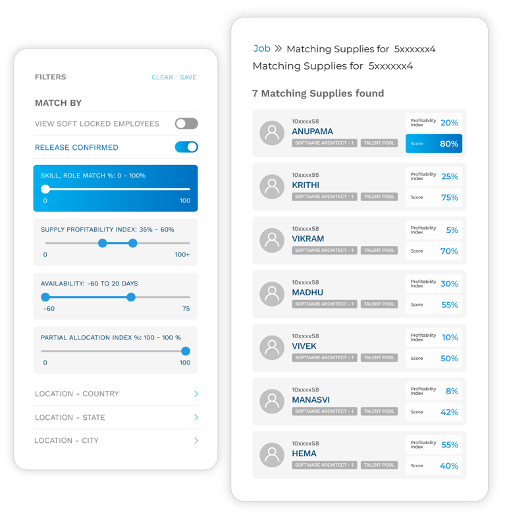
- End-to-end Internal Application Management helps organisations integrate disparate systems of record into one system of intelligence.
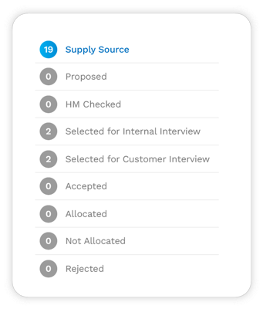
- ‘Profitability Index’ empowers Resource Managers to scrutinize the cost and billing aspects of a resource. It enables them to gauge the contribution margin while making allocation decisions, thereby ensuring optimized resource utilization.
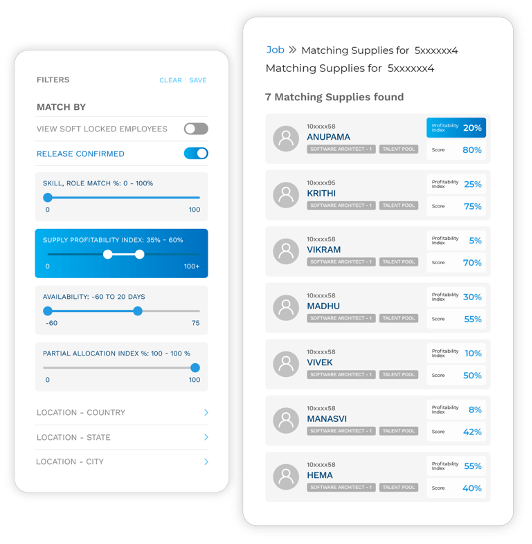
EDGE Mobility uses our sophisticated Smart AI EDGE GraphTM - an astute knowledge graph created by analyzing over 25 million Job Descriptions & 20 million Profiles. The brain behind everything our products, the graph maps each employee’s characteristics, skillsets, and experiences to deliver algorithms that help organizations build effective, agile and resilient teams.
Internal hiring and mobility remain crucial strategies, even as the economy recovers. The multitude of benefits, including increased retention, engagement, agility, reduced hiring costs and time, and the development of high-potential employees, make internal mobility vital for organizations. By embracing internal mobility and utilizing tools like EDGE Mobility, companies can ensure talent retention, prepare future leaders, and reap the rewards of a skilled and agile workforce.